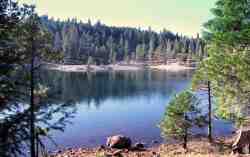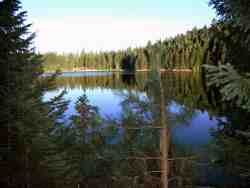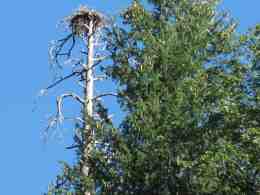These Motorhome Driver Safety Tips Will Keep You Safe On The Highway
Being on the open road is why we bought our Class C Motorhomes... or is it?
Did we buy our rigs to drive
or to park them somewhere nice?
I'm thinking we would really prefer to park the things and use a dinghy to explore an area. However, on occasion we do have to move from point A to point B. With this in mind, I figure that we shouldn't be having to do this with a lot of mental distractions.
Therefore, I thought a little discussion on some motorhome driver safety tips may be of benefit to free up our minds just a bit.
- At the top of any driver safety tips list is the need to slow down. Stuff happens a LOT quicker at high speed. And remember, when you drive fast, all you can do is watch the road... missing a lot of scenery as we rush from place to place.
- If you slow down, you can better enjoy the scenery. Just because we are in a motorhome, it doesn't mean that we cannot take advantage of vistas as they develop in front of us. It is a mindset issue. Relax and enjoy the ride.
- If you slow down, you can better enjoy the scenery. Just because we are in a motorhome, it doesn't mean that we cannot take advantage of vistas as they develop in front of us. It is a mindset issue. Relax and enjoy the ride.
- Learn to project yourself "out ahead" of the motorhome. Because of the slow response time in these things, we need to project our awareness out in front of us. Be aware of what is going on around five seconds or more in the future.
- This will give you ample opportunity to deal with an emergency before you are knee deep into it. Keep your eyes moving and check your mirrors often... is there someone who is sneaking into your "blind spot"?
- Be observant... if you know what the dynamic situation is in front of your rig, as well as keeping track of what is happening behind it, you will have a much better time reacting properly in an emergency situation.
Driver Safety Tips... On How To Adjust Your Mirrors to Find the "Blind Spots" - This will give you ample opportunity to deal with an emergency before you are knee deep into it. Keep your eyes moving and check your mirrors often... is there someone who is sneaking into your "blind spot"?
- On the subject of mirrors; proper adjustment is a very important driver safety tip. For some of us, our mirrors are adjusted so that if we look into the passenger side mirror, we will see the side of our motorhome and some of the lane we are driving in... this would indicate that our mirrors are not adjusted to our best advantage.
- For proper adjustment, the trick is to lean to the right towards the middle of the coach when adjusting the passenger side mirror. It is from this position that you will want to see the side of the coach.
- After making this adjustment you want to lean back toward the left again into your normal position behind the wheel. From this position, you should be able to see the lane next to your rig where the traffic will be and not the side of your rig.
- This is what we want to see because this is where the traffic is going to be. It may take a bit of time to get used to this new view, but you will experience fewer instances of having a blind spot next to you.
Driver Safety Tips... On Passing Vehicles - For proper adjustment, the trick is to lean to the right towards the middle of the coach when adjusting the passenger side mirror. It is from this position that you will want to see the side of the coach.
- Here is another one of those common sense motorhome driver safety tips that, if ignored, may get us into trouble... You do not want to be passing on the right (especially a truck).
- On occasion, we have all done this. Driving in traffic is after all a dynamic situation. Sometimes there may good reasons for passing on the right of a moving vehicle.
- Let's just say this is not a good habit to get into because it can sometimes be considered an unexpected action. Doing the unexpected will get you into trouble. Plus, if you are passing on the right, chances are you may be speeding... not good.
- On occasion, we have all done this. Driving in traffic is after all a dynamic situation. Sometimes there may good reasons for passing on the right of a moving vehicle.
- If you do pass a vehicle, do not pull back in font of it until you can see the whole vehicle in your rear view mirror. This vehicle may flash his lights at you (a lot of folks think this indicates that you are clear to move over). However, if you are unsure about this, just wait until you are sure of your right-of-way.
- This is one of those driver safety tips that borders on an urban myth. Do we really know what a driver in another vehicle is attempting to communicate with his lights flashing?
- Bottom line... no matter what he is doing with his lights, you would be responsible if you were to clip him by moving over too soon.
- Anyway, if he does flash at you and you chose to act on it, flash your back running lights as an acknowledgment, or a "thank you" for his effort.
- This is one of those driver safety tips that borders on an urban myth. Do we really know what a driver in another vehicle is attempting to communicate with his lights flashing?
- Avoid any vehicle's blind spot. This is especially important with big trucks and buses.
- Just like you, trucks and buses need more time to stop and pick up speed. Therefore, you do not want to press them. Give them some slack when maneuvering in traffic. Always use your signals well in advance to indicate your intentions. Nobody likes surprises.
Driver Safety Tips... On Avoiding Traffic And Adverse Weather Conditions - Holiday traffic can be a pain. If you do have to drive on a holiday, be careful... believe it or not, there are more accidents on Thanksgiving weekend than on New Year's weekend.
- Most of these are caused by drunk drivers. It won't matter to you that you have not been drinking if a drunk driver runs you off the road. You are still off the road!
- Something else that may sound silly, but overeating and driving may cause you to be groggy on the drive home. It may be a good idea to put off driving for awhile.
- Something else that may sound silly, but overeating and driving may cause you to be groggy on the drive home. It may be a good idea to put off driving for awhile.
- Most of these are caused by drunk drivers. It won't matter to you that you have not been drinking if a drunk driver runs you off the road. You are still off the road!
- If you hear an emergency vehicle coming your way, pull over to the side of the road. Turn down the music if you are not sure of what you are hearing.
- Day or night, after pulling off to the side of the highway, you can put, or keep, your directional signals on showing your intention of staying out of the way and yielding.
- Day or night, after pulling off to the side of the highway, you can put, or keep, your directional signals on showing your intention of staying out of the way and yielding.
- Another of the more important driver safety tips would be to avoid snow and ice if at all possible... especially at night. We all know that the weather is hard to predict. However, with a device like the Midland WR120B all hazard alert weather radio,
there is a much greater chance of avoiding foggy conditions and/or heavy rain with ice and snow. This isn't rocket science... use a weather radio and stay parked somewhere safe until the roads are clear and the conditions improve.
If you must drive... slow down. In a heavy wind, you may be making lanes changes without turning the wheel. If you find yourself going below 55 due to fog and heavy rain, put your blinkers on. Let the folks behind you know you are there and not going as fast as they may be expecting. Driver Safety Tips... On Driving At Night
And Using A Good GPS System - Driving at night has some advantages and disadvantages. You may get better mileage and usually have less traffic. Temperatures are usually cooler after dark so there would be less strain on the AC. However, the down side is that you may potentially miss some scenery.
Driving at night may or may not be important for every individual because, obviously, not every situation is the same. The trick is to be flexible and not get locked into a routine without thinking.- Traffic conditions are typically less congested in the major cities after dark, and you may find yourself having less of a chance of being stuck in traffic and burning precious fuel.
- Traffic conditions are typically less congested in the major cities after dark, and you may find yourself having less of a chance of being stuck in traffic and burning precious fuel.
- However, if you do not have a good GPS system like a Rand McNally TripMaker RVND 7710 GPS
you may have a bit of a challenge moving about after dark in a new and unfamiliar setting.
With a modern GPS system, designed specifically for large motorhomes, you can go a long way towards avoiding tight squeezes when you can least afford it.
Most of our interstate system is well suited for our motorhomes. However, as soon as we get off the freeway in a strange town, all bets are off. It soon becomes a trial and error experience.
An advantage of the RVND 7710 is that after you have put in your rig's height and width dimensions, it will not direct you to go down a street that will get you into trouble.
It will also give you warning on high winds and tight curves. You can also avoid the low overhangs and the tight spaces we can get into when we do not know exactly where we are going. - As I stated above, driving at night has its pros and cons. It is basically a personal decision. Some of us have more difficulty seeing or have a harder time with bright lights after dark. This can be fatiguing and may cause disorientation.
- Out in the country and away from the city lights, you may have a greater chance of smacking a critter during early evening and morning hours. Animals can and do cross the road.
- You should drive slower after dark and do not drive past your visibility. If you can only see 3 seconds in front of you, don't drive in the 5 second zone. You will be driving in 2 seconds of blindness because you simply cannot see further than that... this is really a bad idea.
- As I stated above, driving at night has its pros and cons. It is basically a personal decision. Some of us have more difficulty seeing or have a harder time with bright lights after dark. This can be fatiguing and may cause disorientation.
Years ago I used to go off road in an old Chevy Blazer. I used to carry around a huge 1 million plus candle power spot light. This plugged into my 12 volt system and it bailed me out on more than one occasion.
There was many a time that this light opened a path back to civilization for me. If this type of light was good enough to direct me over the barren off road areas, it is more than up to the task of getting you off the highway safely in an emergency.
Therefore, if you are out away from city lights and need to pull off of the road for whatever reason, a very basic and one of the more important of the driver safety tips would be to know just where you are going. A good spotlight makes a huge difference... like the Blue Max Marine 2 Million Candlepower Rechargeable Spotlight
Most of these driver safety tips are simple enough. There are probably many more that could be added to the list. My attempt here was not to be conclusive, but to make an attempt to have you view this subject through a different perspective.
Utilizing driver safety tips is really about the mindset of the Class C Motorhome owner. It is easy to get wrapped up trying to get down the road with a sense of urgency... you know, "ya gotta get there" mentality. However, if we slow down and enjoy the here and now, things simply flow easier... and this makes for a safer environment!
Return To Top Of Page
Leave These Motorhome Driving Safety Tips Will Keep You Safe On The Highway And Return To: Being Safe On The Road Requires A Plan
Leave These Motorhome Driver Safety Tips Will Keep You Safe On The Highway And Return To The Class C Motorhome: How To Achieve The Maximum RV Lifestyle!
YOUR STORIES
Onan AC Generator Wouldn't Start
1995 Tioga Montara
Had a Leak - Ouch!
A Simple Way To Put An Electrical Thermostat On A Small Space Heater
In A Truck Camper!
A Great Destinaton, With An Unexpected Outcome!
INTERNET SALE!!
Now Available From Magellan! - RoadMate RV9145-Lm 7" Touchscreen GPS W/Lifetime Maps Portable Receiver Made For Motorhomes...
With an Internet Price Of Just $249.08 At Camping World!
Including Lifetime Maps!
Test Link
Below: For An Alternative Destination... A Four Mile Hike Around Sugar Pine Reservoir

A Good Place To Begin The Joshua M. Hardt Memorial Trail Is At The Dam. This 3.5 Mile Trail Is Good For Foot Traffic And Bicycles... No Motorized stuff

The Manzanita Day Use Area Is A Good Place To Sit And Watch The Wind
Play With The Water!

Another View From The Joshua M. Hardt Memorial Trail... Morning and Evening Are The Best Times To Hike This Trail. The Still Reflections Will Capture Your Attention

You May Want To Bring A Camera... There Are Large Birds Of Prey High In The Ski






